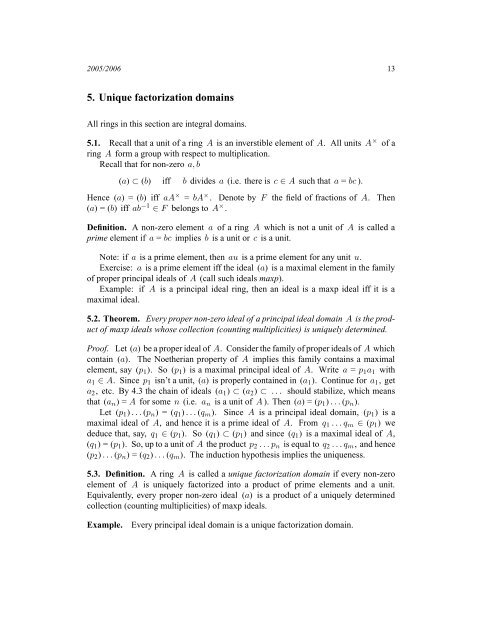Algebra (Unknown 27). - Index of
Algebra (Unknown 27). - Index of
Algebra (Unknown 27). - Index of
You also want an ePaper? Increase the reach of your titles
YUMPU automatically turns print PDFs into web optimized ePapers that Google loves.
2005/2006 13<br />
5. Unique factorization domains<br />
All rings in this section are integral domains.<br />
5.1. Recall that a unit <strong>of</strong> a ring A is an inverstible element <strong>of</strong> A. All units A × <strong>of</strong> a<br />
ring A form a group with respect to multiplication.<br />
Recall that for non-zero a, b<br />
(a) ⊂ (b) iff b divides a (i.e. there is c ∈ A such that a = bc ).<br />
Hence (a) = (b) iff aA × = bA × . Denote by F the field <strong>of</strong> fractions <strong>of</strong> A. Then<br />
(a) = (b) iff ab −1 ∈ F belongs to A × .<br />
Definition. A non-zero element a <strong>of</strong> a ring A which is not a unit <strong>of</strong> A is called a<br />
prime element if a = bc implies b is a unit or c is a unit.<br />
Note: if a is a prime element, then au is a prime element for any unit u.<br />
Exercise: a is a prime element iff the ideal (a) is a maximal element in the family<br />
<strong>of</strong> proper principal ideals <strong>of</strong> A (call such ideals maxp).<br />
Example: if A is a principal ideal ring, then an ideal is a maxp ideal iff it is a<br />
maximal ideal.<br />
5.2. Theorem. Every proper non-zero ideal <strong>of</strong> a principal ideal domain A is the product<br />
<strong>of</strong> maxp ideals whose collection (counting multiplicities) is uniquely determined.<br />
Pro<strong>of</strong>. Let (a) be a proper ideal <strong>of</strong> A. Consider the family <strong>of</strong> proper ideals <strong>of</strong> A which<br />
contain (a). The Noetherian property <strong>of</strong> A implies this family contains a maximal<br />
element, say (p 1 ). So (p 1 ) is a maximal principal ideal <strong>of</strong> A. Write a = p 1 a 1 with<br />
a 1 ∈ A. Since p 1 isn’t a unit, (a) is properly contained in (a 1 ). Continue for a 1 , get<br />
a 2 , etc. By 4.3 the chain <strong>of</strong> ideals (a 1 ) ⊂ (a 2 ) ⊂ . . . should stabilize, which means<br />
that (a n ) = A for some n (i.e. a n is a unit <strong>of</strong> A ). Then (a) = (p 1 ) . . . (p n ).<br />
Let (p 1 ) . . . (p n ) = (q 1 ) . . . (q m ). Since A is a principal ideal domain, (p 1 ) is a<br />
maximal ideal <strong>of</strong> A, and hence it is a prime ideal <strong>of</strong> A. From q 1 . . . q m ∈ (p 1 ) we<br />
deduce that, say, q 1 ∈ (p 1 ). So (q 1 ) ⊂ (p 1 ) and since (q 1 ) is a maximal ideal <strong>of</strong> A,<br />
(q 1 ) = (p 1 ). So, up to a unit <strong>of</strong> A the product p 2 . . . p n is equal to q 2 . . . q m , and hence<br />
(p 2 ) . . . (p n ) = (q 2 ) . . . (q m ). The induction hypothesis implies the uniqueness.<br />
5.3. Definition. A ring A is called a unique factorization domain if every non-zero<br />
element <strong>of</strong> A is uniquely factorized into a product <strong>of</strong> prime elements and a unit.<br />
Equivalently, every proper non-zero ideal (a) is a product <strong>of</strong> a uniquely determined<br />
collection (counting multiplicities) <strong>of</strong> maxp ideals.<br />
Example.<br />
Every principal ideal domain is a unique factorization domain.

















